At this point in the trip I became something that I can not put into words… I became atemporal. I existed without time… I existed through an infinite amount of time. This concept is impossible to comprehend without having actually perceived it. Even now in retrospect it is hard to comprehend it. But I do know that I lived an eternity that night… - G.T. Currie. “Impossible to Understand Reality: An Experience with LSD(“LSD - Erowid Exp - ’Impossible to Understand Reality’,” n.d.)“
Time distortion is an effect that makes the passage of time feel difficult to keep track of and wildly distorted. – PsychonautWiki
Introduction
What is time? When people ask this question it is often hard to tell what they are talking about. Indeed, without making explicit one’s background philosophical assumptions this question will usually suffer from a lot of ambiguity. Is one talking about the experience of time? Or is one talking about the physical nature of time? What sort of answer would satisfy the listener? Oftentimes this implicit ambiguity is a source of tremendous confusion. Time distortion experiences deepen the mystery; the existence of exotic ways of experiencing time challenges the view that we perceive the passage of physical time directly. How to disentangle this conundrum?
Modern physics has made enormous strides in pinning down what physical time is. As we will see, one can reduce time to causality networks, and causality to patterns of conditional statistical independence. Yet in the realm of experience the issue of time remains much more elusive.
In this article we provide a simple explanatory framework that accounts for both the experience of time and its relation to physical time. We then sketch out how this framework can be used to account for exotic experiences of time. We end with some thoughts pertaining the connection between the experience of time and valence (the pleasure-pain axis), which may explain why exotic experiences of the passage of time are frequently intensely emotional in nature.
To get there, let us first lay out some key definitions and background philosophical assumptions:
Key Terminology: Physical vs. Phenomenal Time
Physical Time: This is the physical property that corresponds to what a clock measures(April 29 and 2013., n.d.). In philosophy of time we can distinguish between eternalism and presentism. Eternalism postulate that time is a geometric feature of the universe, best exemplified with “block universe” metaphor (i.e. where time is another dimension alongside our three spatial dimensions). Presentism, instead, postulates that only the present moment is real; the past and the future are abstractions derived from the way we experience patterns in sequences of events. The present is gone, and the future has yet to come.
Now, it used to be thought that there was a universal metronome that dictated “what time it is” in the universe. With this view one could reasonably support presentism as a viable account of time. However, ever since Einstein’s theory of relativity was empirically demonstrated we now know that there is no absolute frame of reference. Based on the fundamental unity of space and time as presented by general relativity, and the absence of an absolute frame of reference, we find novel interesting arguments in favor of eternalism and against presentism (e.g. the Rietdijk–Putnam argument). On the other hand, presentists have rightly argued that the ephemeral nature of the present is self-revealing to any subject of experience. Indeed, how can we explain the feeling of the passage of time if reality is in fact a large geometric “static” structure? While this article does not need to take sides between eternalism and presentism, we will point out that the way we explain the experience of time will in turn diminish the power of presentist arguments based on the temporal character of our experience.
Phenomenal Time: This is the way in which the passing of time feels like. Even drug naïve individuals can relate to the fact that the passage of time feels different depending on one’s state of mind. The felt sense of time depends on one’s level of arousal (deeply asleep, dreaming, tired, relaxed, alert, wide awake, etc.) and hedonic tone (depressed, anxious, joyful, relaxed, etc.). Indeed, time hangs heavy when one is in pain, and seems to run through one’s fingers when one is having a great time. More generally, when taking into account altered states of consciousness (e.g. meditation, yoga, psychedelics) we see that there is a wider range of experiential phenomena than is usually assumed. Indeed, one can see that there are strange generalizations to phenomenal time. Examples of exotic phenomenal temporalities include: tachypsychia (aka. time dilation), time reversal, short-term memory tracers(Emilsson 2018b), looping(“R/LSD - Time Loops Are Crazy,” n.d.), “moments of eternity(“LSD - Erowid Exp- ’Impossible to Understand Reality’,” n.d.)“, temporal branching(Emilsson 2016b), temporal synchronicities, timelessness, and so on. We suggest that any full account of consciousness ought to be able to explain all of these variants of phenomenal time (among other key features of consciousness(Emilsson 2017a)).
Key Background Assumptions
We shall work under three key assumptions. First, we have indirect realism about perception. Second, we have mereological nihilism in the context of consciousness, meaning that one’s stream of consciousness is composed of discrete “moments of experience.” And third, Qualia Formalism, a view that states that each moment of experience has a mathematical structure whose features are isomorphic to the features of the experience. Let us unpack these assumptions:
Indirect Realism About Perception
This view also goes by the name of representationalism or simulationism (not to be confused with the simulation hypothesis(“Are You Living in a Simulation?” n.d.)). In this account, perception as a concept is shown to be muddled and confused. We do not really perceive the world per se. Rather, our brains instantiate a world-simulation(“David Pearce’s Answer to Did Immanuel Kant Say That Reality as We Perceive It Is Not the Ultimate Reality? - Quora,” n.d.) that tracks fitness-relevant features of our environment. Our sensory apparatus merely selects which specific world-simulation our brain instantiates. In turn, our world-simulations causally covaries with the input our senses receive and the motor responses it elicits. Furthermore, evolutionary selection pressures, in some cases, work against accurate representations of one’s environment (so long as these are not fitness-enhancing(Amanda Gefter 2016)). Hence, we could say that our perception of the world is an adaptive illusion more than an accurate depiction of our surroundings.
A great expositor of this view is Steve Lehar. We recommend his book about how psychonautical experience make clear the fact that we inhabit (and in some sense are) a world-simulation created by our brain. Below you can find some pictures from his “Cartoon Epistemology“, which narrates a dialogue between a direct and an indirect realist about perception:









Steve Lehar also points out that the very geometry of our world-simulation is that of a diorama. We evolved to believe that we can experience the world directly, and the geometry of our world-simulation is very well crafted to keep us under the influence of a sort of spell to makes us believe we are the little person watching the diorama. This world-simulation has a geometry that is capable of representing both nearby regions and far-away objects (and even points-at-infinity), and it represents the subject of experience with a self-model at its projective center.
We think that an account of how we experience time is possible under the assumption that experiential time is a structural feature of this world-simulation. In turn, we would argue that implicit direct realism about perception irrevocably confuses physical time and phenomenal time. For if one assumes that one somehow directly perceives the physical world, doesn’t that mean that one also perceives time? But in this case, what to make of exotic time experiences? With indirect realism we realize that we inhabit an inner world-simulation that causally co-varies with features of the environment and hence resolve to find the experience of time within the confines of one’s own skull.
Discrete Moments of Experience
A second key assumptions is that experiences are ontologically unitary rather than merely functionally unitary. The philosophy of mind involved in this key assumption is unfortunately rather complex and easy to misunderstand, but we can at least say the following. Intuitively, as long as one is awake and alert, it feels like one’s so-called “stream of consciousness” is an uninterrupted and continuous experience. Indeed, at the limit, some philosophers have even argued that one is a different person each day; subjects of experience are, as it were, delimited by periods of unconsciousness. We instead postulate that the continuity of experience from one moment to the next is an illusion caused be the way experience is constructed. In reality, our brains generate countless “moments of experience” every second, each with its own internal representation of the passage of time and the illusion of a continuous diachronic self.(Gallois 2016)
Contrast this discretized view of experience with deflationary accounts of consciousness (which insist that there is no objective boundary that delimits a given moment of experience) and functionallist accounts(Emilsson 2017e) of consciousness (which would postulate that experience is smeared across time over the span of hundreds of milliseconds).
The precise physical underpinnings of a moment of experience have yet to be discovered, but if monistic physicalism(Stoljar 2021) is to survive, it is likely that the (physical) temporal extension that a single moment of experience spans is incredibly thin (possibly no more than 10-13 seconds). In this article we make no assumptions about the actual physical temporal extension of a moment of experience. All we need to say is that it is “short” (most likely under a millisecond).
It is worth noting that the existence of discrete moments of experience supports an Empty Individualist(Emilsson 2015) account of personal identity. That is, a person’s brain works as an experience machine that generates many conscious events every second, each with its own distinct coordinates in physical space-time and unique identity. We would also argue that this ontology may be compatible with Open Individualism, but the argument for this shall be left to a future article.
Qualia Formalism
This third key assumption states that the quality of all experiences can be modeled mathematically. More precisely, for any given moment of experience, there exists a mathematical object whose mathematical features are isomorphic the the features of the experience. At the Qualia Research Institute we take this view and run with it to see where it takes us. Which mathematical object can fully account for the myriad structural relationships between experiences is currently unknown. Yet, we think that we do not need to find the One True Mathematical Object in order to make progress in formalizing the structure of subjective experience. In this article we will simply invoke the mathematical object of directed graphs in order to encode the structure of local binding of a given experience. But first, what is “local binding?” I will borrow David Pearce’s explanation of the terms involved:
The “binding problem,” also called the “combination problem,” refers to the mystery of how the micro-experiences mediated by supposedly discrete and distributed neuronal edge-detectors, motion-detectors, shape-detectors, colour-detectors, etc., can be “bound” into unitary experiential objects (“local” binding) apprehended by a unitary experiential self (“global” binding). Neuroelectrode studies using awake, verbally competent human subjects confirm that neuronal micro-experiences exist. Classical neuroscience cannot explain how they could ever be phenomenally bound. As normally posed, the binding problem assumes rather than derives the emergence of classicality. – Non-Materialist Physicalism by David Pearce
In other words, “local binding” refers to the way in which the features of our experience seem to be connected and interwoven into complex phenomenal objects. We do not see a chair as merely a disparate set of colors, edges, textures, etc. Rather, we see it as an integrated whole with fine compositional structure. Its colors are “bound” to its edges which are “bound” to its immediate surrounding space and so forth.
A simple toy model for the structure of an experience can be made by saying that there are “simple qualia” such as color and edges, and “complex qualia” formed by the binding of simple qualia. In turn, we can represent an experience as a graph where each node is a simple quale and each edge is a local binding connection. The resulting globally connected graph corresponds to the “globally bound” experience. Each “moment of experience” is, thus, coarsely at any rate, a network.
While this toy model is almost certainly incomplete (indeed some features of experience may require much more sophisticated mathematical objects to be represented properly), it is fair to say that the rough outline of our experience can be represented with a network-like skeleton encoding the local binding connections. More so, as we will see, this model will suffice to account for many of the surprising features of phenomenal time (and its exotic variants).
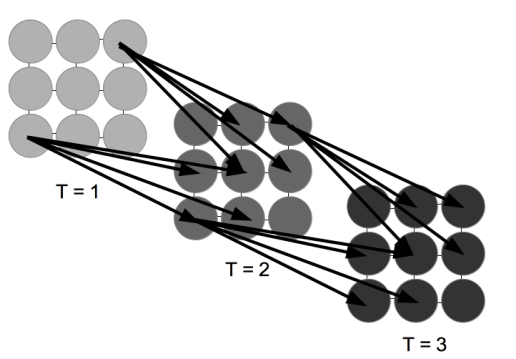
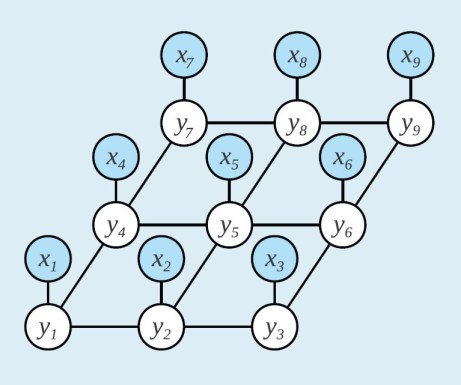
Timeless Causality
While both physical and phenomenal time pose profound philosophical conundrums, it is important to denote that science has made a lot of progress providing formal accounts of physical time. Confusingly, even Einstein’s theory of general relativity is time-symmetric, meaning that the universe would behave the same whether time was moving forwards or backwards. Hence relativity does not provide, on its own, a direction to time. What does provide a direction to time are properties like the entropy gradient (i.e. the direction along which disorder is globally increasing) and, the focus of this article, causality as encoded in the network of statistical conditional independence. This is a mouthful, let us tackle it in more detail.
In Timeless Causality(“Timeless Causality - LessWrong,” n.d.) Yudkowsky argues one can tell the direction of causality, (and hence of the arrow of time) by examining how conditioning on events inform us about other events. We recommend reading the linked article for details (and for a formal account read SEP’s entry on the matter(Hitchcock 2020)).

In the image above we have a schematic representation of two measurables (1 & 2) at several times (L, M, and R). The core idea is that we can determine the flow of causality by examining the patterns of statistical conditional independence, with questions like “if I’ve observed L1 and L2, do I gain information about M1 by learning about M2?” and so on1.
Along the same lines Wolfram has done research(Wolfram, n.d.) on how time may emerge in rule-based network modifications automata:

Intriguingly, these models of time and causality are tenseless and hence eternalist. The whole universe works as a unified system in which time appears as an axis rather than a metaphysical universal metronome. But if eternalism is true, how come we can feel the passage of time? If moments of experience exist, how come we seem to experience movement and action? Shouldn’t we experience just a single static “image,” like seeing a single movie frame without being aware of the previous ones? We are now finally ready tackle these questions and explain how time may be encoded in the structure of one’s experience.
Pseudo-Time Arrow

In the image above we contrast physical and phenomenal time explicitly. The top layer shows the physical state of a scene in which a ball is moving along a free-falling parabolic trajectory. In turn, a number of these states are aggregated by a process of layering (second row) into a unified “moment of experience.” As seen on the third row, each moment of experience represents the “present scene” as the composition of three slices of sensory input with a time-dependent dimming factor. Namely, the scene experienced is approximated with a weighted sum of three scenes with the most recent one being weighted the highest and the oldest the least.
In other words, at the coarsest level of organization time is encoded by layering the current input scene with faint after-images of very recent input scenes. In healthy people this process is rather subtle yet always present. Indeed, after-images are an omnipresent feature of sensory modalities (beyond sight).
A simple model to describe how after-images are layered on top of each other to generate a scene with temporal depth involves what we call “time-dependent qualia decay functions.” This function determines how quickly sensory (and internal) impressions fade over time. With e.g. psychedelics making this decay function significantly fatter (long-tailed) and stimulants making it slightly shorter (i.e. higher signal-to-noise ratio at the cost of reduced complex image formation).
With this layering process going on, and the Qualia Formalist model of experience as a network of local binding, we can further find a causal structure in experience akin to that in physical time (as explained in Timeless Causality):
Again, each node of the network represents a simple quale and each edge represents a local binding relationship between the nodes it connects. Then, we can describe the time-dependent qualia decay function as the probability that a node or an edge will vanish at each (physical) time step.
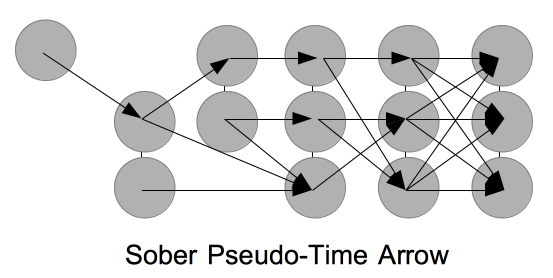
With a sufficiently large network one would be able to decode the direction of causality (and hence of time) using the same principles of statistical conditional independence used to account for physical time. What we are proposing is that this underlies what time feels like.
Now that we understand what the pseudo-time arrow is, what can we do with it?
Explanatory Power: How the Pseudo-Time Arrow Explains Exotic Phenomenal Time
Let us use this explanatory framework on exotic experiences of time. That is, let us see how the network of local binding and its associated pseudo-time arrows can explain unusual experiences of time perception.
To start we should address the fact that tachypsychia (i.e. time dilation) could either mean (a) that “one experiences time passing at the same rate but that this rate moves at a different speed relative to the way clocks tick compared to typical perception” or, more intriguingly, (b) that “time itself feels slower, stretched, elongated, etc.”
The former (a) is very easy to explain, while the latter requires more work. Namely, time dilation of the former variety can be explained by an accelerated or slowed down sensory sampling rate in such a way that the (physical) temporal interval between each layer is either longer or shorter than usual. In this case the structure of the network does not change; what is different is how it maps to physical time. If one were on a sensory deprivation chamber and this type of time dilation was going on one would not be able to say so since the quality of phenomenal time (as encoded in the network of local binding) remains the same as before. Perhaps compare how it feels like to see a movie in slow-motion relative to seeing it at its original speed while being perfectly sober. Since one is sober either way, what changes is how quickly the world seems to move, not how one feels inside.
The latter (b) is a lot more interesting. In particular, phenomenal time is often incredibly distorted when taking psychedelics in a way that is noticeable even in sensory deprivation chambers. In other words, it is the internal experience of the passage of time that changes rather than the layering rate relative to the external world. So how can we explain that kind of phenomenal time dilation?
Psychedelics
The most straightforward effect of psychedelics one can point out with regards to the structure of one’s experience is the fact that qualia seems to last for much longer than usual. This manifests as “tracers” in all sensory modalities. Using the vocabulary introduced above, we would say that psychedelics change the time-dependent qualia decay function by making it significantly “fatter.” While in sober conditions the positive after-image of a lamp will last between 0.2 and 1 second, on psychedelics it will last anywhere between 2 and 15 seconds. This results in a much more pronounced and perceptible change in the layering process of experience. Using Lehar’s diorama model of phenomenal space, we could represent various degrees of psychedelic intoxication with the following progression:





The first image is what one experiences while sober. The second is what one experiences if one takes, e.g. 10 micrograms of LSD (i.e. microdosing(Branwen 2012)), where there is a very faint additional layer but is at times indistinguishable from sober states. The third, fourth, and fifth image represent what tracers may feel like on ~50, ~150, and ~300 micrograms of LSD, respectively. The last image is perhaps most reminiscent of DMT experiences, which provide a uniquely powerful and intense high-frequency layering at the onset of the trip.
In the graphical model of time we could say that the structure of the network changes by (1) a lower probability for each node to vanish in each (physical) time step, and (2) an even lower probability for each edge to vanish after each (physical) time step. The tracers experienced on psychedelics are more than just a layering process; the density of connections also increases. That is to say, while simple qualia lasts for longer, the connections between them are even longer-lasting. The inter-connectivity of experience is enhanced(Keim, n.d.).
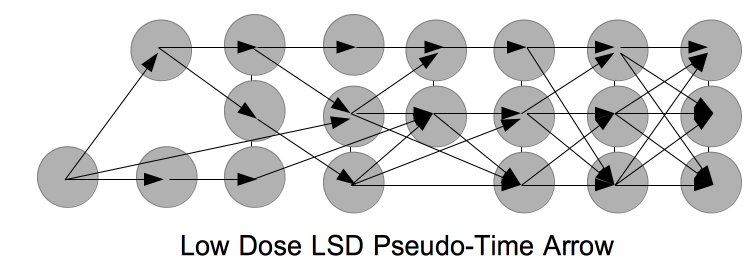
This explains why time seems to move much more slowly on psychedelics. Namely, each moment of experience has significantly more temporal depth than a corresponding sober state. To illustrate this point, here is a first-person account of this effect:
A high dose of LSD seems to distort time for me the worst… maybe in part because it simply lasts so long. At the end of an LSD trip when i’m thinking back on everything that happened my memories of the trip feel ancient. When you’re experiencing the trip it’s possible to feel time slowing down, but more commonly for me I get this feeling when I think back on things i’ve done that day. Like “woah, remember when I was doing this. That feels like it was an eternity ago” when in reality it’s been an hour. – Shroomery(“Shroomery - Magic Mushrooms (Shrooms) Demystified,” n.d.) user Subconscious in the tread “How long can a trip feel like?(“How Long Can a Trip Feel Like? - the Psychedelic Experience - Shroomery Message Board,” n.d.)“
On low doses of psychedelics, phenomenal time may seem to acquire a sort of high definition unusual for sober states. The incredible (and accurate) visual acuity of threshold DMT experiences is a testament to this effect, and it exemplifies what a densified pseudo-time arrow feels like:
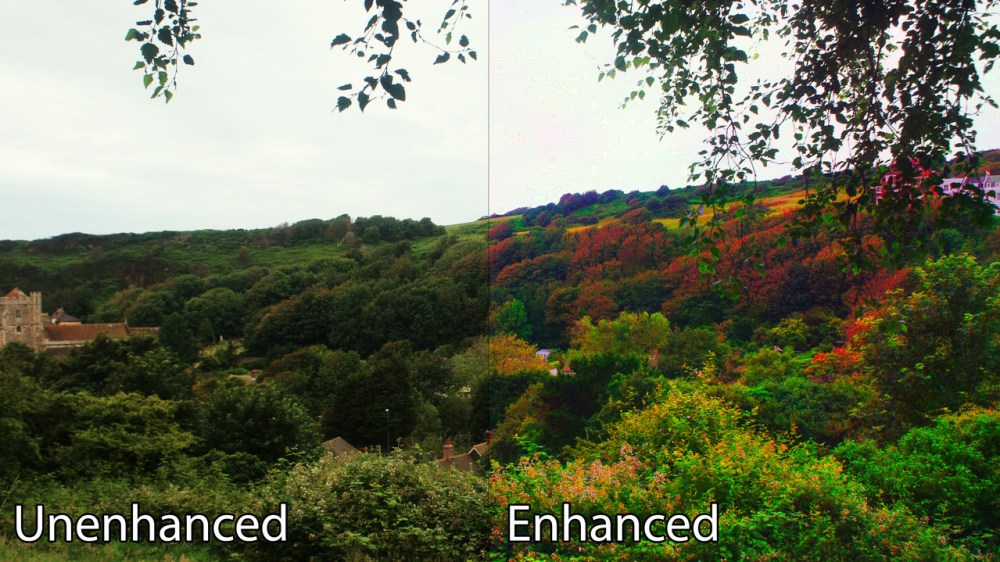
But this is not all. Psychedelics, in higher doses, can lead to much more savage and surrealistic changes to the pseudo-time arrow. Let us tackle a few of the more exotic variants with this explanatory framework:
Timeloops
This effect feels like being stuck in a perfectly-repeating sequence of events outside of the universe in some kind of Platonic closed timelike curve. People often accidentally induce this effect by conducting repetitive tasks or listening to repetitive sounds (which ultimately entrain this pattern). For most people this is a very unsettling experience since it produces a pronounce feeling of helplessness due to making you feel powerless about ever escaping the loop.
In terms of the causal network, this experience could be accounted for with a loop in the pseudo-time arrow of experience:
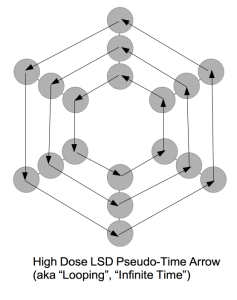
Moments of Eternity
Subjectively, so-called “Moments of Eternity” are extremely bizarre experiences that have the quality of being self-sustaining and unconditioned. It is often described in mystical terms, such as “it feels like one is connected to the eternal light of consciousness with no past and no future direction.” Whereas time loops lack some of the common features of phenomenal time such as a vanishing past, moments of eternity are even more alien as they also lack a general direction for the pseudo-time arrow.
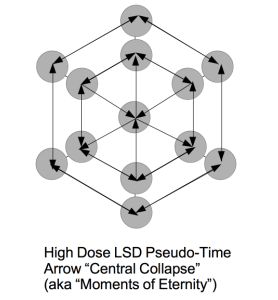
Both time loops and moments of eternity arise from the confluence of a slower time-dependent qualia decay function and structural annealing (which is typical of feedback(“Video Feedback Simulation,” n.d.)). As covered in previous posts(Emilsson 2018a), as depicted in numerous psychedelic replications, and as documented in PsychonautWiki, one of the core effects of psychedelics is to lower the symmetry detection threshold. Visually, this leads to the perception of wallpaper symmetry groups covering textures (e.g. grass, walls, etc.). But this effect is much more general than mere visual repetition; it generalizes to the pseudo-time arrow! The texture repetition via mirroring, gyrations, glides, etc. works indiscriminately across (phenomenal) time and space. As an example of this, consider the psychedelic replication gifs below and how the last one nearly achieves a standing-wave structure. On a sufficient dose, this can anneal into a space-time crystal, which may have “time looping” and/or “moment of eternity” features.










Temporal Branching
As discussed in a previous post, a number of people report temporal branching on high doses of psychedelics. The reported experience can be described as simultaneously perceiving multiple possible outcomes of a given event, and its branching causal implications. If you flip a coin, you see it both coming up heads and tails in different timelines, and both of these timelines become superimposed in your perceptual field. This experience is particularly unsettling if one interprets it through the lens of direct realism about perception. Here one imagines that the timelines are real, and that one is truly caught between branches of the multiverse. Which one is really yours? Which one will you collapse into? Eventually one finds oneself in one or another timeline with the alternatives having been pruned. An indirect realist about perception has an easier time dealing with this experience as she can interpret it as the explicit rendering of one’s predictions about the future in such a way that they interfere with one’s incoming sensory stimuli. But just in case, in the linked post we developed an empirically testable predictions from the wild possibility (i.e. where you literally experience information from adjacent branches of the multiverse) and tested it using quantum random number generators (and, thankfully for our collective sanity, obtained null results).
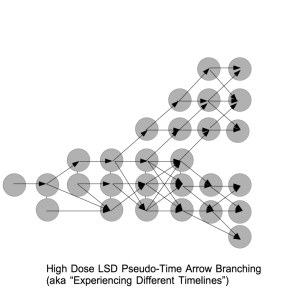
Timelessness
Finally, in some situations people report the complete loss of a perceived time arrow but not due to time loops, moments of eternity, or branching, but rather, due to scrambling. This is less common on psychedelics than the previous kinds of exotic phenomenal time, but it still happens, and is often very disorienting and unpleasant (an “LSD experience failure mode” so to speak). It is likely that this also happens on anti-psychotics and quite possibly with some anti-depressants, which seem to destroy unpleasant states by scrambling the network of local binding (rather than annealing it, as with most euphoric drugs).
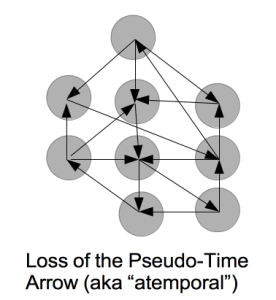
In summary, this framework can tackle some of the weirdest and most exotic experiences of time. It renders subjective time legible to formal systems. And although it relies on an unrealistically simple formalism for the mathematical structure of consciousness, the traction we are getting is strong enough to make this approach a promising starting point for future developments in philosophy of time perception.
We will now conclude with a few final thoughts…
Hyperbolic Geometry
Intriguingly, with compounds such as DMT, the layering process is so fast that on doses above the threshold level one very quickly loses track of the individual layers. In turn, one’s mind attempts to bind together the incoming layers, which leads to attempts of stitching together multiple layers in a small (phenomenal) space. This confusion between layers compounded with a high density of edges is the way we explained the unusual geometric features of DMT hallucinations, such as the spatial hyperbolic symmetry groups expressed in its characteristic visual texture repetition (cf. eli5(Emilsson 2017b)). One’s mind tries to deal with multiple copies of e.g. the wall in front, and the simplest way to do so is to stitch them together in a woven Chrysanthemum pattern with hyperbolic wrinkles.
Implementation Level of Abstraction
It is worth noting that this account of phenomenal time lives at the algorithmic layer of Marr’s levels of abstraction, and hence is an algorithmic reduction (cf. Algorithmic Reduction of Psychedelic States(Emilsson 2016a)). A full account would also have to deal with how these algorithmic properties are implemented physically. The point being that a phenomenal binding plus causal network account of phenomenal time work as an explanation space whether the network itself is implemented with connectome-specific harmonic waves(Emilsson 2017d), serotonergic control-interruption(“The Control Interrupt Model of Psychedelic Action,” n.d.), or something more exotic(“Turning Consciousness Upside down: Magic Mushrooms and the Fractal Brain Hierarchy,” n.d.).
Time and Valence
Of special interest to us is the fact that both moments of eternity and time loops tend to be experienced with very intense emotions. One could imagine that finding oneself in such an altered state is itself bewildering and therefore stunning. But there are many profoundly altered states of consciousness that lack a corresponding emotional depth. Rather, we think that this falls out of the very nature of valence and the way it is related to the structure of one’s experience.
In particular, the symmetry theory of valence(Emilsson 2017c) (STV) we are developing at the Qualia Research Institute posits that the pleasure-pain axis is a function of the symmetry (and anti-symmetry) of the mathematical object whose features are isomorphic to an experience’s phenomenology. In the case of the simplified toy model of consciousness based on the network of local binding connections, this symmetry may manifest in the form of regularity within and across layers. Both in time loops and moments of eternity we see a much more pronounced level of symmetry of this sort than in the sober pseudo-time arrow structure. Likewise, symmetry along the pseudo-time arrow may explain the high levels of positive valence associated with music, yoga, orgasm, and concentration meditation. Each of these activities would seem to lead to repeating standing waves along the pseudo-time arrow, and hence, highly valence states. Future work shall aim to test this correspondence empirically.
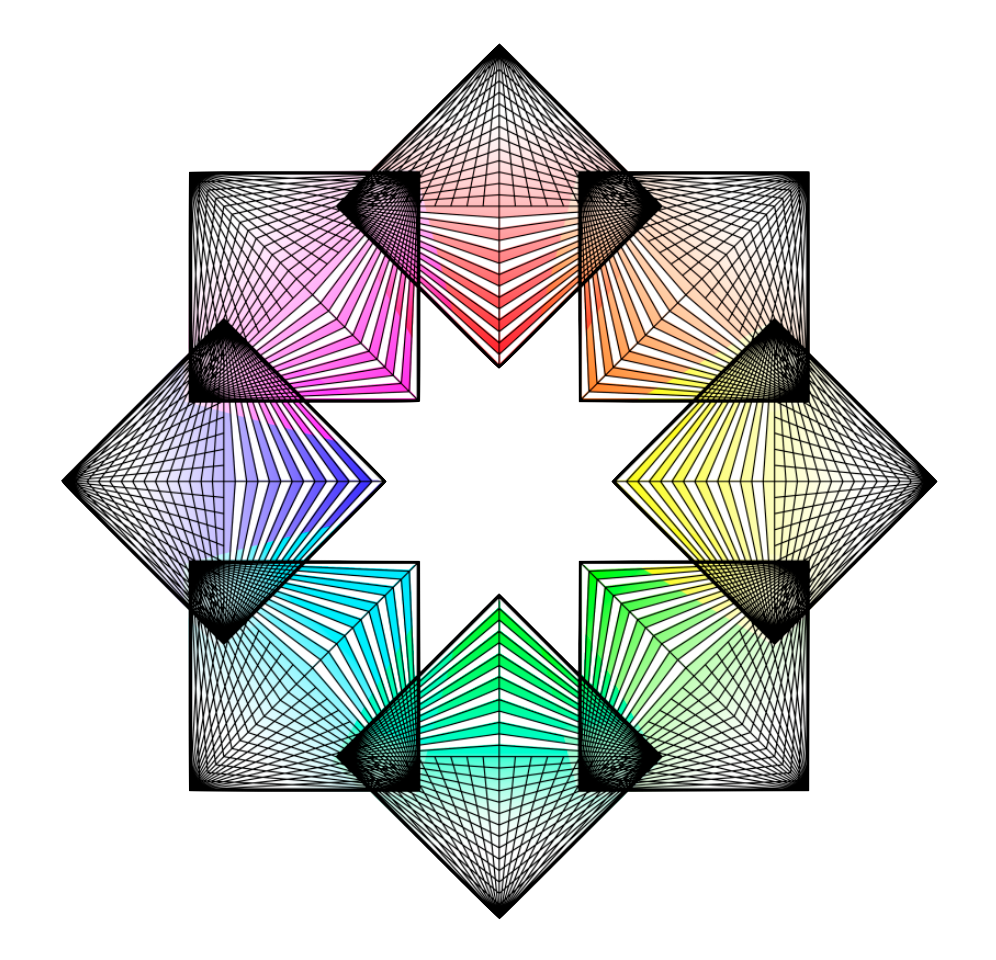
Acknowledgements
Thanks to: Mike Johnson, David Pearce, Romeo Stevens, Justin Shovelain, Andrés Silva Ruiz, Liam Brereton, and Enrique Bojorquez for their thoughts about phenomenal time and its possible mathematical underpinnings. And to Alfredo Valverde for pointing me to the Erlangen program
Images from “Cartoon Epistemology” by Steven Lehar are reprinted with permission.
Thank you Hunter Meyer for converting this piece to Distill for R Markdown format.
Tags
Consciousness, Psychedelics, Phenomenology, Qualia, Experiment, Hedonic Tone, Personal Identity, Symmetry, Valence
As Yudkowsky puts it:
Suppose that we do know L1 and L2, but we do not know R1 and R2. Will learning M1 tell us anything about M2? […]
The answer, on the assumption that causality flows to the right, and on the other assumptions previously given, is no. “On each round, the past values of 1 and 2 probabilistically generate the future value of 1, and then separately probabilistically generate the future value of 2.” So once we have L1 and L2, they generate M1 independently of how they generate M2.
But if we did know R1 or R2, then, on the assumptions, learning M1 would give us information about M2. […]
Similarly, if we didn’t know L1 or L2, then M1 should give us information about M2, because from the effect M1 we can infer the state of its causes L1 and L2, and thence the effect of L1/L2 on M2.↩︎